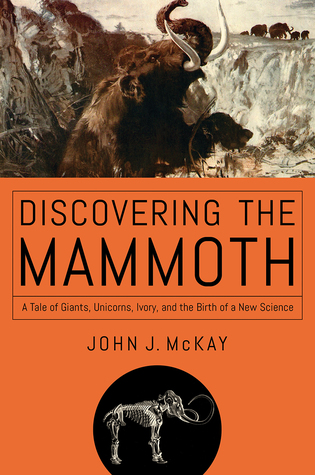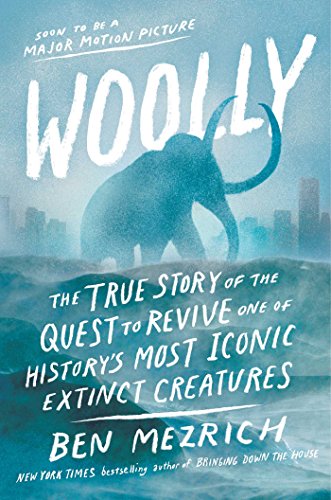 Format read: hardcover provided by the publisher
Format read: hardcover provided by the publisherFormats available: hardcover, paperback, ebook
Genre: science history, nonfiction
Length: 264 p.
Publisher: Pegasus Books
Date Released: August 8th 2017
Purchasing Info: Author’s Website, Publisher’s Website, Goodreads, Amazon, Barnes & Noble, Kobo, Book Depository
Today, we know that a mammoth is an extinct type of elephant that was covered with long fur and lived in the north country during the ice ages. But how do you figure out what a mammoth is if you have no concept of extinction, ice ages, or fossils? Long after the last mammoth died and was no longer part of the human diet, it still played a role in human life. Cultures around the world interpreted the remains of mammoths through the lens of their own worldview and mythology.
When the ancient Greeks saw deposits of giant fossils, they knew they had discovered the battle fields where the gods had vanquished the Titans. When the Chinese discovered buried ivory, they knew they had found dragons’ teeth. But as the Age of Reason dawned, monsters and giants gave way to the scientific method. Yet the mystery of these mighty bones remained. How did Enlightenment thinkers overcome centuries of myth and misunderstanding to reconstruct an unknown animal?
The journey to unravel that puzzle begins in the 1690s with the arrival of new type of ivory on the European market bearing the exotic name “mammoth.” It ends during the Napoleonic Wars with the first recovery of a frozen mammoth. The path to figuring out the mammoth was traveled by merchants, diplomats, missionaries, cranky doctors, collectors of natural wonders, Swedish POWs, Peter the Great, Ben Franklin, the inventor of hot chocolate, and even one pirate.
McKay brings together dozens of original documents and illustrations, some ignored for centuries, to show how this odd assortment of characters solved the mystery of the mammoth and, in doing so, created the science of paleontology.
 Format read: eARC provided by the publisher via Edelweiss
Format read: eARC provided by the publisher via EdelweissFormats available: hardcover, paperback, large print, ebook, audiobook
Genre: science history, nonfiction
Length: 304 p.
Publisher: Atria Books
Date Released: July 4th 2017
Purchasing Info: Author’s Website, Publisher’s Website, Goodreads, Amazon, Barnes & Noble, Kobo, Book Depository
Science fiction becomes reality in this Jurassic Park-like story of the genetic resurrection of an extinct species—the woolly mammoth—by the bestselling author of The Accidental Billionaires and The 37th Parallel.
“With his knack for turning narrative nonfiction into stories worthy of the best thriller fiction” (Omnivoracious), Ben Mezrich takes us on an exhilarating true adventure story from the icy terrain of Siberia to the cutting-edge genetic labs of Harvard University. A group of young scientists, under the guidance of Dr. George Church, the most brilliant geneticist of our time, works to make fantasy reality by sequencing the DNA of a frozen woolly mammoth harvested from above the Arctic circle, and splicing elements of that sequence into the DNA of a modern elephant. Will they be able to turn the hybrid cells into a functional embryo and bring the extinct creatures to life in our modern world?
Along with Church and his team of Harvard scientists, a world-famous conservationist and a genius Russian scientist plan to turn a tract of the Siberian tundra into Pleistocene Park, populating the permafrost with ancient herbivores as a hedge against an environmental ticking time bomb. More than a story of genetics, this is a thriller illuminating the race against global warming, the incredible power of modern technology, the brave fossil hunters who battle polar bears and extreme weather conditions, and the ethical quandary of cloning extinct animals. Can we right the wrongs of our ancestors who hunted the woolly mammoth to extinction—and at what cost?
When I started reading Woolly, I remembered that I had another book about the same subject in my TBR pile. I thought about reading both, but couldn’t quite manage the time. Then I had a brilliant idea – why not have Galen read the other mammoth book and then do a joint review? The two books are not as close in content as I originally thought, but they do dovetail quite nicely. And here’s the result.
Our Review:
Ossip Shumachov’s mammoth—the first pulled mostly intact from the Siberian permafrost and deposited in a museum, represents the culmination of centuries of debate about the meaning of the strange, large bones found in all the places modern elephants do not live. John J. McKay’s book, Discovering the Mammoth: A Tale of Giants, Unicorns, Ivory, and the Birth of a New Science, explores how the process of scientific discovery is often not so much about seeing something for the first time—but figuring out how to name it and where to place it in its historical setting.
As McKay explains, the story of discovering the mammoth is in part the story of remembering them. After all, there was a time when humans drew pictures of living mammoths and mastodons. However, a few centuries ago it was not at all clear (except, presumably, to a handful of hunters ln Siberia) that mammoth fossils came from anything resembling an elephant that had become extinct. Various explanations were tried over the years. For example, mammoths bones were sometimes thought to have come from human giants of biblical myth or Roman legends. Alternatively, it was thought that they were scattered by the Biblical Deluge or left behind by invading armies (though there was a big objection to the latter: why would armies bury dead elephants in such quantity but never think to hang on to the ivory?).
In the course of exploring the rediscovery of the mammoth, McKay covers a lot of ground, including the development of the sciences in a westernizing Russia; how the discovery of mastodons with unexpected teeth in the Americas unsettled a nascent consensus that Eurasian mammoths were just elephants out of place; and how scientific communication developed over the centuries. Unfortunately, an unusually high number of typographical errors mar the text.
McKay also acknowledges the part that people who were not scientists, diplomats, and monarchs had to play in his tale. Mammoth bones are often found not fully mineralized; when an unearthed bone crumbles, it is so very often the unnamed workmen who get blamed. Ossip Shumachov was the Eveki hunter who found the thawing carcass the mammoth that is more commonly known as Mikhail Adam’s, after the botanist who collected it and sent it on to St. Petersburg. While Adam’s role in helping to describe should not be discounted—we should also not discount the fact that due to his high-handed way of impressing local labor to pack it up during an important hunting season, the Evenki never forgot—and became much more reluctant to share knowledge of their finds.
McKay closes his book with an expression of gratitude to the mammoth:
We followed mammoths. We learned from them. We learned about them and created a new science. We miss them so much that we want to resurrect them from extinction more than any other animal.
So we are.
And that’s the story in Ben Mezrich’s Woolly: The True Story of the Quest to Revive One of History’s Most Iconic Extinct Creatures.
There are currently multiple efforts going on, in different countries using different methods, to de-extinct the woolly mammoth, and bring back the ultimate in charismatic megafauna.
Woolly does its level best to turn a story of sleep-starved post-docs, chilly laboratories far-fetched cloning and meticulous gene splicing experiments into edge-of-the-seat adventure, and it very nearly succeeds.
The quest to rescue one of the most iconic of extinct species from the dustbin of history is certainly worthy of a great story. And like any great story, it needs heroes. In the case of Woolly, that hero is Dr. George Church, the leader of an ever-expanding cadre of researchers who are fully invested in the number one rule at Church Labs – that nothing is impossible.
The story of the quest to de-extinct the mammoth travels from the death of the last remaining mammoth herd on remote Wrangell Island over 3,000 years ago to a point about four years from now, when Church’s experiments have succeeded. The quest also shifts in time from George Church’s earliest years to the present day, and all over the globe from Harvard to Wrangell to Siberia to Seoul.
It’s a dizzying ride, moving back and forth in both time and space over the life of the project, its quirky and charismatic director, and its possibilities for saving both the mammoth, and ourselves.
But as fascinating a story as Woolly is, and as good a job as the author does in breaking its cutting edge science down into chunks that a non-scientist can understand, it also has plenty of frustrations.
The narrative sweeps back and forth in time, from that misty point four years from now to the 1950s and every point in between – and not in any order that the reader, or at least this reader, can discern. Each of the building blocks of this story are individually compelling, but they don’t gel together into a whole. Just as I got invested in one person or one project, the perspective would shift and we would suddenly be years earlier – or later.
The device of setting both the beginning and ending of the tale in that misty “four years from now” adds a nice bit of dramatic framing to a story that already has plenty of drama in it. But it also detracts from its veracity. That frame is science fiction, where the rest of the book purports to be science fact. And most of it is. But I can’t help but wonder where that dividing line really is.
Galen’s Reality Rating for Discovering the Mammoth: B
Marlene’s Reality Rating for Woolly is also a solid B.













